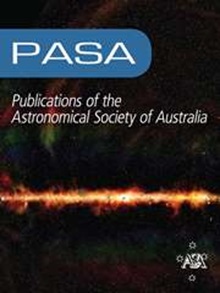The Rapid ASKAP Continuum Survey IV: continuum imaging at 1367.5 MHz and the first data release of RACS-mid
IF 4.6
3区 物理与天体物理
Q1 ASTRONOMY & ASTROPHYSICS
Publications of the Astronomical Society of Australia
Pub Date : 2023-06-12
DOI:10.1017/pasa.2023.31
引用次数: 0
Abstract
Abstract The Australian SKA Pathfinder (ASKAP) is being used to undertake a campaign to rapidly survey the sky in three frequency bands across its operational spectral range. The first pass of the Rapid ASKAP Continuum Survey (RACS) at 887.5 MHz in the low band has already been completed, with images, visibility datasets, and catalogues made available to the wider astronomical community through the CSIRO ASKAP Science Data Archive (CASDA). This work presents details of the second observing pass in the mid band at 1367.5 MHz, RACS-mid, and associated data release comprising images and visibility datasets covering the whole sky south of $\delta_{\text{J2000}}=+49^\circ$ . This data release incorporates selective peeling to reduce artefacts around bright sources, as well as accurately modelled primary beam responses. The Stokes I images reach a median noise of 198 $\mu$ Jy PSF $^{-1}$ with a declination-dependent angular resolution of 8.1–47.5 arcsec that fills a niche in the existing ecosystem of large-area astronomical surveys. We also supply Stokes V images after application of a widefield leakage correction, with a median noise of 165 $\mu$ Jy PSF $^{-1}$ . We find the residual leakage of Stokes I into V to be $\lesssim 0.9$ – $2.4$ % over the survey. This initial RACS-mid data release will be complemented by a future release comprising catalogues of the survey region. As with other RACS data releases, data products from this release will be made available through CASDA.快速ASKAP连续体调查IV: 1367.5 MHz连续体成像和RACS-mid的首次数据发布
澳大利亚SKA探路者(ASKAP)正在进行一项运动,在其工作光谱范围内的三个频段内快速测量天空。快速ASKAP连续调查(RACS)在887.5 MHz低频段的第一次通过已经完成,图像,能见度数据集和目录通过CSIRO ASKAP科学数据档案(CASDA)向更广泛的天文界提供。本工作详细介绍了在1367.5 MHz中频的第二次观测通道,RACS-mid,以及相关的数据发布,包括覆盖$\delta_{\text{J2000}}=+49^\circ$以南整个天空的图像和能见度数据集。该数据发布包含选择性剥离,以减少明亮光源周围的伪影,以及准确模拟主光束响应。Stokes I图像的中位噪声达到198 $\mu$ Jy PSF $^{-1}$,与赤纬相关的角分辨率为8.1-47.5弧秒,填补了现有大面积天文调查生态系统中的空白。我们还提供了应用宽视场泄漏校正后的Stokes V图像,中值噪声为165 $\mu$ Jy PSF $^{-1}$。我们发现Stokes I到V的剩余泄漏为$\lesssim 0.9$ - $2.4$ % over the survey. This initial RACS-mid data release will be complemented by a future release comprising catalogues of the survey region. As with other RACS data releases, data products from this release will be made available through CASDA.
本文章由计算机程序翻译,如有差异,请以英文原文为准。
求助全文
约1分钟内获得全文
求助全文
来源期刊
CiteScore
5.90
自引率
9.50%
发文量
41
审稿时长
>12 weeks
期刊介绍:
Publications of the Astronomical Society of Australia (PASA) publishes new and significant research in astronomy and astrophysics. PASA covers a wide range of topics within astronomy, including multi-wavelength observations, theoretical modelling, computational astronomy and visualisation. PASA also maintains its heritage of publishing results on southern hemisphere astronomy and on astronomy with Australian facilities.
PASA publishes research papers, review papers and special series on topical issues, making use of expert international reviewers and an experienced Editorial Board. As an electronic-only journal, PASA publishes paper by paper, ensuring a rapid publication rate. There are no page charges. PASA''s Editorial Board approve a certain number of papers per year to be published Open Access without a publication fee.

 求助内容:
求助内容: 应助结果提醒方式:
应助结果提醒方式:


